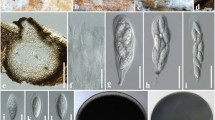Abstract
The sequences of the internal transcribed spacer (ITS) region of 18S–26S nrDNA for a sample of 16 taxa from theInuleae s. str. and two outgroup taxa are analysed cladistically with PAUP. A consensus tree of the four most parsimonious cladograms is presented. Three different tests of cladogram stability are conducted (Bremer support, parsimony jackknifing and bootstrapping); all tests indicate a high degree of support for the basal nodes of the tree. The ITS phylogeny of the tribe is compared with previous hypotheses based on morphological data. The position ofAnisopappus as sister group to the rest of the tribe is supported by the molecular data, but the proposed subdivision ofInuleae s. str. into a paleate grade group and an epaleate clade is not. The interpretation of the character evolution of, e.g. receptacular paleae and pappus features within the tribe is discussed.
Similar content being viewed by others
References
Anderberg, A. A., 1989: Phylogeny and reclassification of the tribeInuleae (Asteraceae). — Canad. J. Bot.67: 2277–2296.
—, 1991a: Taxonomy and phylogeny of the tribeGnaphalieae (Asteraceae). — Opera Bot.104: 1–195.
—, 1991b: Taxonomy and phylogeny of the tribeInuleae (Asteraceae). — Pl. Syst. Evol.176: 75–123.
—, 1991c: Taxonomy and phylogeny of the tribePlucheeae (Asteraceae). — Pl. Syst. Evol.176: 145–177.
—, 1994: TribeInuleae. — InBremer, K.:Asteraceae, cladistics & classification, pp. 273–291. — Portland, Oregon: Timber Press.
Baldwin, B. G., 1992: Phylogenetic utility of the internal transcribed spacers of nuclear ribosomal DNA in plants: an example from theCompositae. — Molec. Phylogenet. Evol.1: 3–16.
—, 1993: Molecular phylogenetics ofCalycadenia (Compositae) based on ITS sequences of nuclear ribosomal DNA: chromosomal and morphological evolution reexamined. — Amer. J. Bot.80: 222–238.
—, 1995: The ITS region of nuclear ribosomal DNA: a valuable source of evidence on Angiosperm phylogeny. — Ann. Missouri Bot. Gard.82: 247–277.
Bremer, K., 1987: Tribal interrelationships of theAsteraceae. — Cladistics3: 210–253.
—, 1988: The limits of amino acid sequence data in angiosperm phylogenetic reconstruction. — Evolution42: 795–803.
—, 1994a:Asteraceae, cladistics & classification. — Portland, Oregon: Timber Press.
—, 1994b: Branch support and tree stability. — Cladistics10: 295–304.
Carpenter, J. M., 1988: Choosing among multiple equally parsimonious cladograms. — Cladistics4: 291–296.
Chase, M. W., Hills, H. H., 1991: Silica gel: An ideal material for field preservation of leaf samples for DNA studies. — Taxon40: 215–220.
Doyle, J. J., Doyle, J. S., 1987: A rapid DNA isolation procedure for small quantities of fresh leaf tissue. — Phytochem. Bull.19: 11–15.
Eldenäs, P. K., Anderberg, A. A., 1996: A cladistic analysis ofAnisopappus (Asteraceae:Inuleae). — Pl. Syst. Evol.199: 167–192.
Eriksson, T., Wikström, N., 1995: AutoDecay ver. 3.0. — Stockholm: Computer program distributed by the authors, Botaniska Institutionen, Stockholm University.
Farris, J. S., Albert, V. A., Källersjö, M., Lipscomb, D., Kluge, A. G., 1996: Parsimony jack-knifing outperforms neighbor-joining. — Cladistics12: 11–124.
Felsenstein, J., 1985: Confidence limits on phylogenies: an approach using the bootstrap. — Evolution39: 783–791.
Goloboff, P. A., 1991: Homoplasy and the choice among cladograms. — Cladistics7: 215–232.
Gonzalez, I. L., Sylvester, J. E., Smith, T. F., Stambolian, D., Schmickel, R. D., 1990: Ribosomal RNA gene sequences and hominid phylogeny. — Molec. Biol. Evol.7: 203–219.
Hillis, D. M., Bull, J. J., 1993: An empirical test of bootstrapping as a method for assessing confidence in phylogenetic analysis. — Syst. Biol.42: 182–192.
Hoffmann, O., 1890:Compositae. —Engler, A., Prantl, K., (Eds): Die natürlichen Pflanzenfamilien4(5), pp. 87–387. — Leipzig: Engelmann.
Karis, P. O., 1993: Morphological phylogenetics of theAsteraceae-Asteroideae, with notes on character evolution. — Pl. Syst. Evol.186: 69–93.
—, 1992: Phylogenetic analysis of theCichorioideae (Asteraceae), with emphasis on theMutisieae. — Ann. Missouri Bot. Gard.79: 416–427.
Kim, K., Jansen, R. J., Wallace, R. S., Michaels, H. J., Palmer, J. D., 1992: Phylogenetic implications ofrbcL sequence variation in theAsteraceae. — Ann. Missouri Bot. Gard.79: 428–445.
—, 1995:ndhF sequence evolution and the major clades in the sunflower family. — Proc. Natl. Acad. Sci. USA92: 10379–10383.
Källersjö, M., Farris, J. S., Kluge, A. G., Bult, C., 1992: Skewness and permutation. — Cladistics8: 275–287.
Lee, S. B., Taylor, J. W., 1992: Phylogeny of five fungus-like protoctistan (Phytophthora) species, inferred from the internal transcribed spacers of ribosomal DNA. — Molec. Biol. Evol.9: 636–653.
Maddison, W. P., Maddison, D. R., 1992: MacClade: analysis of phylogeny and character evolution, ver. 3.0. — Sunderland, Massachusetts: Sinauer.
Merxmüller, H., Leins, P., Roessler, H., 1977:Inuleae — systematic review. — InHeywood, V. H., Harborne, J. B., Turner, B. L., (Eds): The biology and chemistry of theCompositae, pp. 577–602. — London: Academic Press.
Saghai-Maroof, M. A., Soliman, K. M., Jorgensen, R. A., Allard, R. W., 1984: Ribosomal DNA spacer-length polymorphisms in barley: Mendelian inheritance, chromosomal location and population dynamics. — Proc. Natl. Acad. Sci. USA81: 8014–8018.
Swofford, D. L., 1993: PAUP: Phylogenetic analysis using parsimony, ver. 3.1.1. Computer program. — Champaign, Illinois: Illinois Natural History Survey.
Thompson, J. D., Higgins, D. G., Gibson, T. J., 1994: CLUSTAL W: improving the sensitivity of progressive multiple sequence alignment through sequence weighting, positions-specific gap penalties an weight matrix choice. — Nucl. Acids Res.22: 4673–4680.
Trueman, J. W. H., 1993: Randomization confounded: a response toCarpenter. — Cladistics9: 101–109.
Wiklund, A., 1987: The genusNauplius (Asteraceae-Inuleae). — Nordic J. Bot.7: 1–23.
Yokota, Y., Kawata, T., Iida, Y., Kato, A., Tanifuji, S., 1989: Nucleotide sequences of the 5.8S rRNA gene and internal transcribed spacer regions in carrot and broad bean ribosomal DNA. — J. Molec. Evol.29: 294–301.
Author information
Authors and Affiliations
Rights and permissions
About this article
Cite this article
Eldenäs, P., Anderberg, A.A. & Källersjö, M. Molecular phylogenetics of the tribeInuleae s. str.(Asteraceae), based on ITS sequences of nuclear ribosomal DNA. Pl Syst Evol 210, 159–173 (1998). https://doi.org/10.1007/BF00985666
Received:
Accepted:
Issue Date:
DOI: https://doi.org/10.1007/BF00985666




